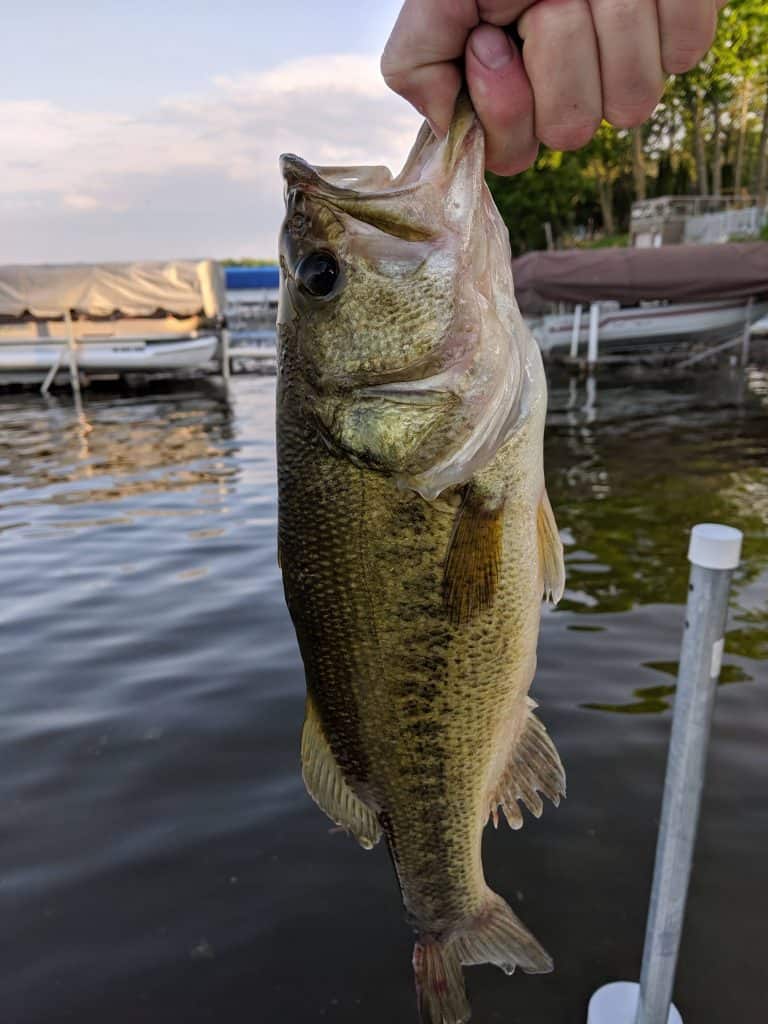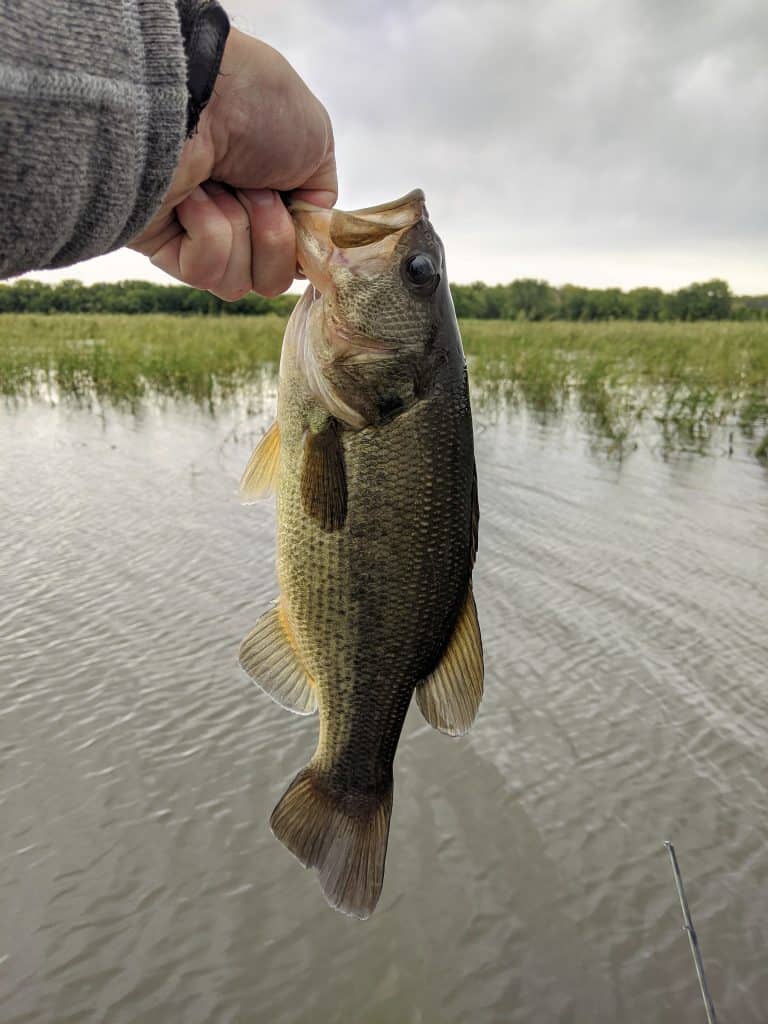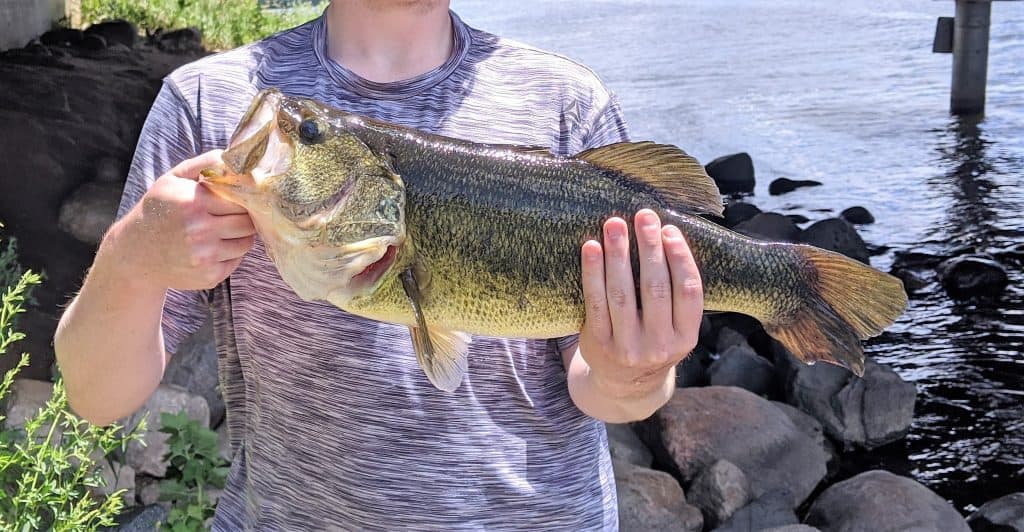Largemouth Bass Description
Micropterus salmoides or commonly known as Largemouth bass can be recognized by the lower jaw that extends past the back edge of the eye.

It is dark green above with silvery sides and belly and a dark stripe across its body. . The underside ranges in color from light green to almost white. They have a nearly divided dorsal fin with the anterior portion containing nine spines and the posterior portion containing 12 to 13 soft rays.
Largemouth Bass are the most popular gamefish in North America and are found in every state except Alaska (and it wouldn’t surprise me if there are a couple hanging out somewhere there as well). They are the subject of countless fishing shows, magazine articles, books, this website, etc.
Largemouth Bass are aggressive fish that can be targeted using a huge variety of techniques, so no matter what kind of fishing you like to do you can probably catch bass with it. In fact, there is not a single category of artificial lure that will not catch bass. Poppers, Soft Plastics, Spoons, Spinners, Jerkbaits, Crankbaits, Spinnerbaits, Swimbaits, etc all will work under the right conditions.
Bass are ambush feeders that pounce on prey that comes by them. Even when they are not feeding, they will often pounce on lures out of sheer aggressiveness. Every bass fisherman probably has a story about catching a tiny bass on a lure that was bigger than it. There is no way it was planning to eat it; the fish just wanted to smack it and show it who was boss.
Largemouth Bass are found in lakes and rivers throughout the US and also in a number of other countries including Japan where they are very popular. They are hardy fish and easily transplanted. Largemouth relate very strongly to cover and structure, so if you find that you can usually find the fish.
Except for humans, adult largemouth bass is the top predators in the aquatic ecosystem. Fry (baby bass) feeds primarily on zooplankton and insect larvae. At about two inches in length, they become active predators. Adults feed almost exclusively on other fish and large invertebrates such as crayfish. Larger fish prey upon smaller bass.

How Big Does A Largemouth Bass Get?
According to the U.S. Fish & Wildlife Service – Largemouth Bass can attain weights of over 20lbs but very, very few fish get anywhere near that size. The world record of 29.5 inches long and weighing 22lbs, 4oz stood for 77 years until it was tied in 2011 in Japan. Any bass over 6lbs is generally a female. The average bass caught is about 18 inches long and weighing around 2lbs.
Largemouth Bass are about at the median in terms of fighting ability for a freshwater fish. They pull decently hard and sometimes try to wrap you up in cover where they are often found. When hooked, they often jump and shake their heads to dislodge hooks. They do not possess a lot of stamina.
Largemouth Bass Spawn
Largemouth bass usually reaches sexual maturity and begin spawning when they are about a year old. Spawning takes place in the spring season when the water temperature first holds steady above 60˚F. In the northern region of the United States and Canada, this usually occurs anywhere from late April until early July. In the southern states, where the largest and healthiest specimens typically inhabit, this process can begin in March and is usually over by June.

Largemouth bass spawn as early as March or as late as June. The males build saucer-shaped nests 20 to 30 inches in diameter and guard the nest and eggs against all intruders. Largemouth bass grow 4 to 6 inches during their first year, 8 to 12 inches in two years, and up to 16 inches in three years. Largemouth bass may live for 13 years.
If you have never caught a Largemouth Bass you should go in the Spring when they are spawning. Depending on what part of the country you are in this could be sometime between March and May. During this time small male bass flood the shallows and can often be easy to spot.
The big females come in for a much shorter time but are more vulnerable to being caught than they usually are. The small male bass can often be caught one after another on drop shotting and other similar techniques. Anyone can feel like a pro bass fisherman during the spawn, even if they don’t have a boat. If you can catch them like that every other time of year then you really are a pro.

Largemouth Bass Tackle & Baits
Tackle for Largemouth Bass varies tremendously depending on the technique you use. You could be using a heavy baitcasting rod with a 50lb braid with a 30lb leader to fish heavy trout imitation swimbaits or a light spinning rod with a 4lb test to fish small drop-shot plastics.
You can read more in-depth about bass tackle and what bait’s to use for bass fishing in a previous article here on Slamming Bass.
Fun Facts About Largemouth Bass
- They can eat prey that is up to 25 to 35 percent of their body length.
- Their average lifespan is ten to sixteen years depending on the habitat and environment.
- An estimated 30 million people fish for largemouth bass in the United States.
- The male guards the eggs after the female lays them. They will hatch in 5 to 10 days.
- Their color can vary depending on the type of water they live in.
- They have a sixth sense called a lateral line that picks up the vibrations of other fish.
- Largemouth bass can see color and are especially attracted to the color red.
- It is the official state fish for Alabama, Georgia, Mississippi, Florida, and Tennessee.
